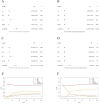Electrolyte prognosis scoring system can predict overall survival in patients with osteosarcoma
- PMID: 39445057
- PMCID: PMC11496286
- DOI: 10.3389/fonc.2024.1466912
Electrolyte prognosis scoring system can predict overall survival in patients with osteosarcoma
Abstract
Osteosarcoma stands as the most prevalent bone tumor, characterized by a heightened tendency for local recurrence and distant metastasis, resulting in a bleak prognosis. Presently, there exists a shortage of novel markers to effectively determine the prognosis of osteosarcoma patients. Recent research indicates that hematological markers partially mirror an individual's microenvironment, offering potential insights into predicting patient prognosis. However, prior studies predominantly focused on the prognostic significance of singular hematological indices, failing to comprehensively represent the tumor microenvironment of patients. In our investigation, we meticulously gathered data on 22 hematological and electrolyte markers, utilizing LASSO Cox regression analysis to devise an Electrolyte Prognostic Scoring System (EPSS). The EPSS encompasses various indicators, including immunity, inflammation, coagulation, and electrolyte levels. Our findings indicate that the EPSS stands as an independent prognostic factor for overall survival among osteosarcoma patients. It serves as a valuable addition to clinical characteristics, adept at discerning high-risk patients from those deemed clinically low-risk. Furthermore, EPSS-based nomograms demonstrate commendable predictive capabilities.
Keywords: OS; electrolyte; hematological markers; osteosarcoma; prognostic nomograms.
Copyright © 2024 Liu, Kang, Li, Li, He, Zhang, Lu, Min and Tu.
Conflict of interest statement
The authors declare that the research was conducted in the absence of any commercial or financial relationships that could be construed as a potential conflict of interest.
Figures






Similar articles
-
Hematological Prognostic Scoring System Can Predict Overall Survival and Can Indicate Response to Immunotherapy in Patients With Osteosarcoma.Front Immunol. 2022 May 6;13:879560. doi: 10.3389/fimmu.2022.879560. eCollection 2022. Front Immunol. 2022. PMID: 35603156 Free PMC article.
-
A Nutritional Metabolism Related Prognostic Scoring System for Patients With Newly Diagnosed Osteosarcoma.Front Nutr. 2022 Apr 28;9:883308. doi: 10.3389/fnut.2022.883308. eCollection 2022. Front Nutr. 2022. PMID: 35571914 Free PMC article.
-
Risk Factors, Prognostic Factors, and Nomograms for Distant Metastasis in Patients With Newly Diagnosed Osteosarcoma: A Population-Based Study.Front Endocrinol (Lausanne). 2021 Jul 30;12:672024. doi: 10.3389/fendo.2021.672024. eCollection 2021. Front Endocrinol (Lausanne). 2021. PMID: 34393996 Free PMC article.
-
Ferroptosis-related lncRNAs guiding osteosarcoma prognosis and immune microenvironment.J Orthop Surg Res. 2023 Oct 19;18(1):787. doi: 10.1186/s13018-023-04286-3. J Orthop Surg Res. 2023. PMID: 37858131 Free PMC article.
-
A New Online Dynamic Nomogram: Construction and Validation of a Predictive Model for Distant Metastasis Risk and Prognosis in Patients with Gastrointestinal Stromal Tumors.J Gastrointest Surg. 2023 Jul;27(7):1429-1444. doi: 10.1007/s11605-023-05706-9. Epub 2023 May 25. J Gastrointest Surg. 2023. PMID: 37231240 Review.
References
-
- Kempf-Bielack B, Bielack SS, Jürgens H, Branscheid D, Berdel WE, Exner GU, et al. . Osteosarcoma relapse after combined modality therapy: an analysis of unselected patients in the Cooperative Osteosarcoma Study Group (COSS). J Clin Oncol Off J Am Soc Clin Oncol. (2005) 23(3):559–68. doi: 10.1200/JCO.2005.04.063 - DOI - PubMed
LinkOut - more resources
Full Text Sources

